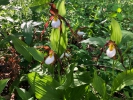|
|
|
|
|
| |
Flasks of
Cypripedium montanum (bridge group 1) -spontaneous |
|
| |
|
|
| |
| Number: |
TN9475 |
| Name: |
Cypripedium montanum (bridge group 1) -spontaneous
|
| Type: |
spontaneous (What's that?) |
|
Click to Enlarge

Pod Parent Blooming Plants |
|
|
|
| |
For additional origin/habitat information supplied courtesy of
Charles and Margaret Baker, see further below, near the bottom of this page.
|
Temperatures we attempt to use in the lab & greenhouse:
| For Species: |
|
Spring, Summer, Autumn: days average 74°F, nights 42°F; best fit is Cool-Cold 64-44°F
(Source:
Baker's Web OSC) |
| For Species: |
|
Winter: days average 38°F, nights 21°F; best fit is Frigid 46-28°F
(Source:
Baker's Web OSC) |
|
About the name...
| Etymology of |
Cypripedium |
|
From Greek "Kypris" Aphrodite; "pedilon" shoe.
(Source:
Pridgeon 1992) |
| Etymology of |
montanum |
|
From Latin "montanus" mountainous, living in the mountains.
(Source:
Mayr & Schmucker 1998) |
| Pronunciation of |
Cypripedium |
|
sip-re-PEE-dee-um
(Source:
Pridgeon 1992) |
| Pronunciation of |
montanum |
|
mon-TAH-num
(Source:
Hawkes 1978) |
|
If you would like to direct someone to this web page, please copy and paste this URL into your email:
http://troymeyers.com/d?019475
| Flask Information |
| Availability: |
Capsules have been harvested, and we are waiting for germination. |
| You should: |
Make a notification request now.
When this germinates, we'll let you know, and you can reserve a flask at that time if you like. Your notification request serves as a place-holder in line for flasks later, so it's best if you place the notification request as early as possible. If you wait, you'll be further down in line for flasks. |
| Expected Flask Price: |
$40.00 per flask of 25 (min.) plants
|
|
You might also want to:
|
View the seed assay for this item.
View items of the same species.
View items of the same genus.
|
| Ordering Information |
| You are not currently logged in. |
|
You must be a registered user and be logged in to reserve a flask or place a notification request. Please log in:
|
|
|
|
|
|
| |
The origin/habitat information below is supplied courtesy of Charles and Margaret Baker
The following information is based on the name of the plant provided by the donor, and assumes that the name is correct. If the plant has been misidentified, then the following information may not be correct.
This text is copyrighted by the Bakers and may not be reproduced without permission.
ORIGIN/HABITAT: The western United States and Canada. The range of
distribution extends southward from the panhandle of S. E. Alaska through
the Canadian Rockies in most of the Canadian province of British Colombia
and the extreme southwestern corner of the province of Alberta, with a
tongue of distribution extending southward through the Idaho panhandle,
the Blue Mountains of northeastern Oregon, and mountains of western
Montana to as far south as the Yellowstone Park region. A western tongue
of distribution extends down the Cascade Mountains of western Washington
and Oregon, dividing in the mountains of southern Oregon and northern
California with a branch extending down the Coast Range of northern
California while an eastern branch extends down the Sierras of eastern
California to as far south as Yosemite. These are plants of the higher
mountain regions, with plants in the Blue Mountains of northeastern Oregon
reported from about 5000 ft. (1520 m). Plants may be found in growing and
flowering in open woods, growing in almost full sun, or deeply shaded
coniferous forests. Jasen (1992) described a typical exposure that
occurred on a sunny exposure along a bluff over a ravine. Plants were
perched on a slope at a forty-five degree angle, with high, mature
coniferous trees scattering the sunlight into patches on the ground below.
The plants were growing in a mat of partially composted coniferous needles
that was 6-10 in. (15-25 cm) deep, lying over a layer of decomposed
granite bedrock so that rain falling in the area percolates downward
through the vegetative mat which retains moisture and helps sustain the
plants during dry periods.
More about this information and the Bakers...
|
|
|
| |
|
|
|